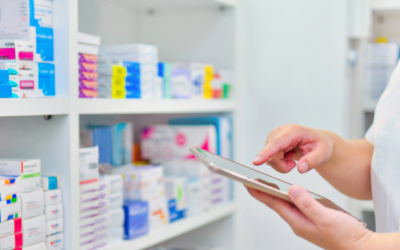Semaglutide Article Series:
In a 2-part series, LighthouseAI will be diving into how the pharma and pharmacy industries are addressing the shortage of semaglutide, as well as the legal and ethical aspects of the phenomenon.
Part 1: Sterile Compounding Solves Semaglutide Access Problems
There has been an incredible rise in popularity of semaglutide and other GLP-1 medications for weight loss. The new demand primarily stems from its sheer effectiveness in propelling weight loss and alongside celebrity endorsement. As demand for the products continues to expand, market dynamics (i.e. availability, overall pricing, and openness by consumers to pay cash) have created an interesting opportunity for sterile compounders, including both 503A compounding pharmacies and 503B outsourcing facilities.
Lack of access to the product has proliferated enough to where even South Park took a swing: “South Park: The End of Obesity” satirizes celebrities’ glamorized usage of weight loss drugs (such as Ozempic) and the inaccessibility of the American health care system.
In this article, we will cover the nuances of sterile compounding (i.e. differences between 503A & 503B), how the industry is quickly adopting to address the lack of access to semaglutide, what role last year’s FDA blessing for “wholesale by 503B to 503A” is playing, and how such involved companies can mitigate federal and state compliance risk.
The Rise of Popularity for Semaglutide and GLP-1 Meds
Since its approval in 2017 as a diabetes treatment, Novo Nordisk’s semaglutide (known by the brand names Ozempic, Rybelsus, and Wegovy) has surged in popularity, becoming one of the most prescribed drugs in the U.S. Combined sales of Ozempic, Rybelsus, and Wegovy have reached $21.1 billion for Novo Nordisk in the five years since launched in 2018. Nearly 2 million people in the U.S. were taking semaglutide in 2021, more than triple the number in 2019.
Access Problems
Both the increased demand and market dynamics of GLP-1 medications are creating access problems for patients looking to use Novo Nordisk’s branded versions of semaglutide, especially Wegovy that is approved for weight management and weight loss in people with or without diabetes.
Market Dynamics
Market dynamics, specifically pricing and lack of insurance coverage have made access to Novo Nordisk’s branded products difficult. Per GoodRx, Wegovy is priced at around $1,350 for a 28-day supply, translating to an annual cost of over $16,000. Combined with the fact that insurance generally doesn’t cover off-label use of product, the branded, injectable version of the drug is out of budget for most Americans.
Dosage Forms & Sizing
In pharmacy, dosage forms and product size are of critical importance in ensuring product effectiveness and patient safety. Injectable forms of semaglutide, like Ozempic, are popular due to their effectiveness and ease of use. However, scaling large-scale sterile manufacturing operations takes incredible capital investment and many years of designing, building, and obtaining regulatory approval. Accordingly, Novo Nordisk has been unable to scale fast enough to meet demand.
Although oral versions of semaglutide are cheaper and more available in the market, only Wegovy is specifically approved and is therefore a ‘known factor’ to consumers for weight loss, preventing demand from shifting to the oral version.
So, with unfulfilled demand based on pricing and shortages, what are would-be patients to do? Well, they are flocking to sterile compounders.
What is Sterile Compounding?
Sterile-compounded medications include injectable drugs, eye drops, and intravenous solutions, where maintaining sterility is crucial for patient safety. This process requires a controlled environment, such as a cleanroom, and follows stringent guidelines to ensure the sterility of the medications which prevent infections for the patients.
Per federal law, Title I of the DSCSA, there are two types of sterile compounding, 503A and 503B. 503A ‘compounding pharmacies’ create customized medications based on specific prescriptions for individual patients, primarily regulated by state pharmacy boards with some federal exemptions. In contrast, 503B ‘outsourcing facilities’ produce sterile drugs in bulk without patient-specific prescriptions. They are regulated by the FDA, must comply with Current Good Manufacturing Practice (CGMP) requirements, and can distribute medications for office use. The key difference lies in the scale of operation and the regulatory oversight, with 503A focusing on individualized care and 503B addressing broader healthcare needs.
Sterile Compounding Solves Both Access Problems
As the opening in the market was created, sterile compounders rushed to fill market demand. On May 20th, Hims & Hers announced their sterile compounding of semaglutide while trading at $14.57 per share starting the Monday they broke the news; since, they closed that same Monday trading at $18.60 per share, a gain of 28%! Investors see this as a massive opportunity for sterile compounders because they solve both access problems.
Cost
On its website, Hims suggests that weekly injections of semaglutide could cost as little as $199 per month or $2,388 annually, about 86% less than Novo’s Wegovy. Sterile compounding pharmacies across the United States are rushing to capitalize on this trend.
Scaling Manufacturing Output
One of the core tenets of Title I of the DSCSA was to address the drug shortage crisis in the United States. Accordingly, 503A and 503B compounders are each adapting to demand much faster than what is possible for large-scale manufacturing operations.
State Compliance as a Solution for Sterile Compounders
So, the business case is there. But what about the regulatory, legal, and ethical considerations?
Regulatory
After the DSCSA was made effective, state regulators rushed to accommodate the new business models, with varying strategies – some, like California, created dedicated license types and out-of-state inspections; while other states adapted existing licensing programs for the new business model.
LighthouseAI helps pharmaceutical companies reduce their risk of non-compliance with state licensing requirements by helping them:
-
- Discover overlooked requirements
- Reduce avoidable deficiencies
- Eliminate lost-and-forgotten tasks
- Increase team productivity through automation
With the unique regulations and complexities of each state’s regulatory agencies, LighthouseAI offers professional assistance to navigate the requirements. Contact us today.
Legal & Ethical Considerations
For more information on the challenges that federal and state governments are facing including counterfeits, use of salt-forms, research-grade product and more, catch our next article!



